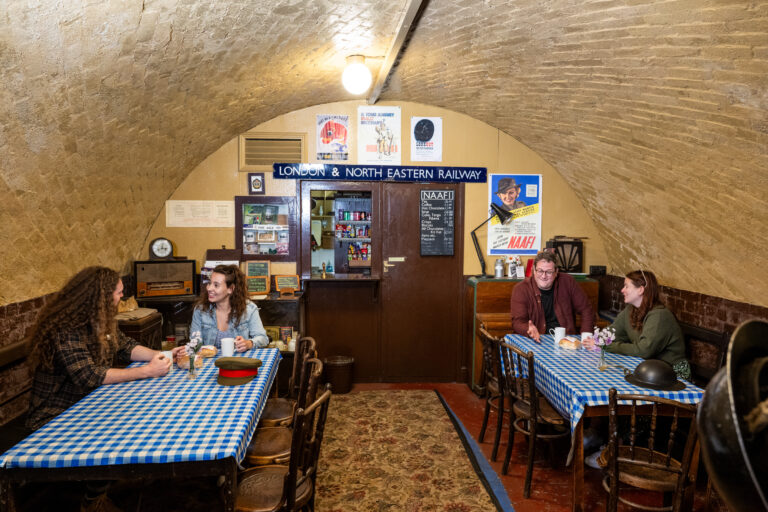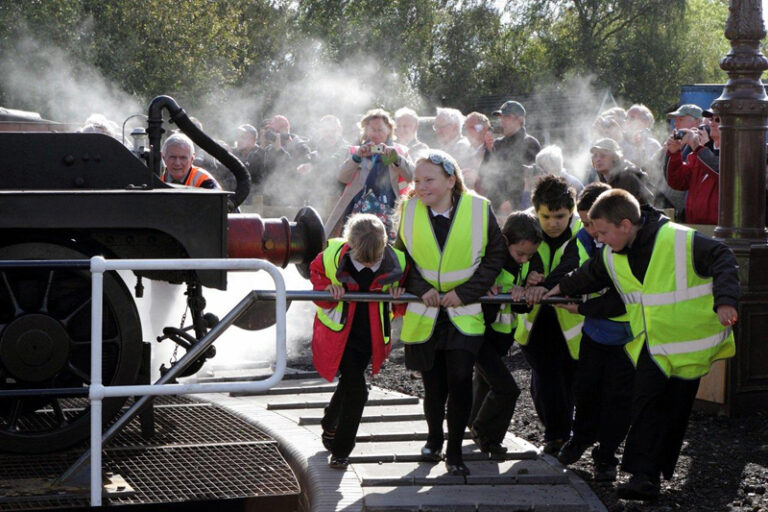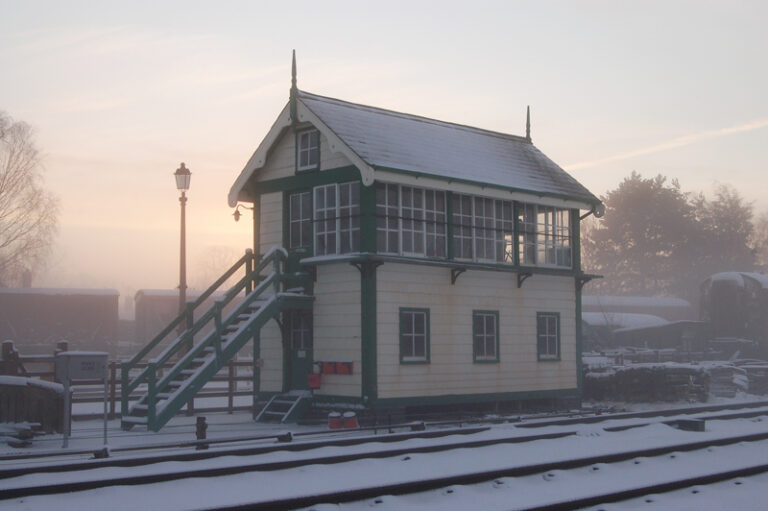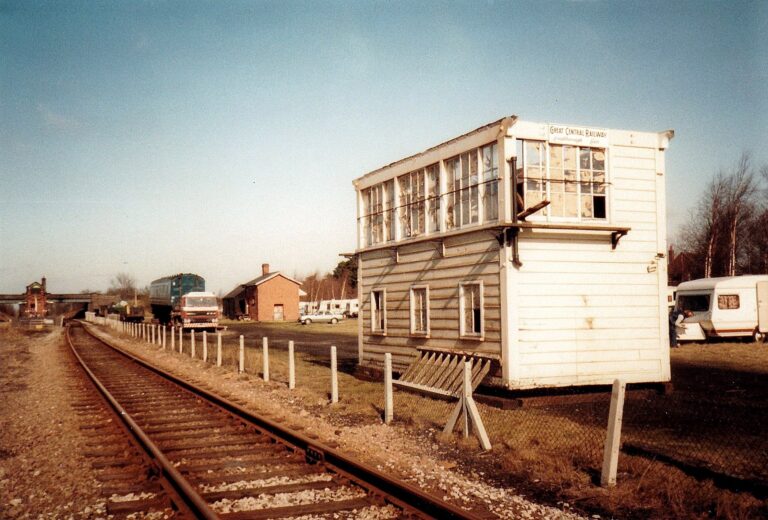Quorn and Woodhouse
Taking you back to Wartime Britain in the 1940s
Quorn & Woodhouse Station was opened in 1899 and was intended to serve the nearby villages of Quorn, Woodhouse and Woodhouse Eaves. There’s a Goods Yard and a Station Master’s house (now a private residence). The Prince of Wales (subsequent King Edward VIII) used the station for hunting trips. Later the station yard was enhanced as part of the preparations for the D-Day invasion. Troops and equipment were loaded here.
Because of the association with the Second World War, the station has been restored to its 1940s condition. The General and Ladies Waiting Rooms are in one building, complete with coal fires and period advertising. In the General Waiting Room, we show films appropriate to the station’s era. There is a disabled-friendly lavatory in the Ladies Waiting Room, together with a baby-changing table.
A second building houses the Booking Office with typical office furniture and with a genuine ticket rack dispensing proper Edmondson (cardboard) tickets.
Under the road bridge is the Air Raid Shelter, which is where the village Home Guard were based during the Second World War. Today you can purchase drinks and snacks in our NAAFI style Refreshment Room which is open on most operating days.
Adding to the wartime theme, notice that we are doing our bit for the war, with our Dig for Victory vegetable garden on the embankment across from Platform No.2 and the old pram collecting scrap metal for the war effort.
Also in the station yard are the former Goods Shed and Weighbridge Office, a re-built Anderson shelter and the Butler-Henderson Café, open 5 days a week for hot and cold food.
Discover & Dine
Key facts
Construction Date
1899 as part of the line expansion
Time Period for Station
Set in War Time Britain during the 1940s
Platforms
134 metres
Must sees
Next to the bridge at the end of Platform No.1
Spot the LNER style mechanical colour-light signal
During the winter months
Stay warm in the waiting room by the coal fire
Under the stairs
The NAAFI style tearoom
NAAFI Style Tearoom
Slip under the road bridge at Quorn and step back in time… period music plays from the radio, the newspapers on the table bring you the latest news from the war effort – but fortunately you won’t need a ration book!
A recreated air raid shelter, the tearoom is presented in NAAFI style (Navy Army and Air Force Institute) – the organisation which still runs recreational facilities for service personnel.
Open at weekends when trains are running, you can sip a cup of tea or coffee, grab a snack and warm yourself by the fire. Wait for your train – or just hide away and escape. Remember though, careless talk costs lives!
Butler Henderson Café
The Butler Henderson Café, located in the station yard at Quorn & Woodhouse Station, is a well-loved spot for visitors to the Great Central Railway. Named after a former director of the line, the café serves a selection of hot and cold food, as well as light refreshments. There’s a covered veranda where visitors can sit and watch the trains go by, making it a great place for a break during a day out on the railway. Toilet facilities are also available on-site. The café is open Wednesday to Friday from 10am to 4pm, and on Saturdays and Sundays from 9am to 4pm, welcoming both railway enthusiasts and passing visitors.
Turntable
Quorn & Woodhouse Station has the rare addition of a fully working sixty-foot turntable. It is available to view whenever the railway is open and in use most weekends, especially during special events.
The turntable was originally built in 1909 by the well-known engineers Cowans Sheldon Ltd of Carlisle, and was first installed at York, now the home of the National Railway Museum.
The Great Central Railway acquired the turntable exactly one hundred years later, in 2009, by which time it was in a derelict condition. Following extensive work by the Railway’s in-house engineers it was renovated and then installed at Quorn & Woodhouse by specialist civil engineering contractors during the late summer of 2011.
Worked by hand, it only needs a team of two to three people to push heavy steam or diesel locomotives around.
Signal Box
The signal box at Quorn & Woodhouse is situated at the south end of the station on the Up side of the line (Up track was the one that led to London, and the ‘Down’ one led away), close to the location of the original box. The box was originally located at Market Rasen and is an MS&L box of circa 1886 vintage – making it the oldest structure on the railway. The structure is all wood and was erected on a new concrete base. The box controls the station area and sidings.
There are several signals of interest. At the north end of Platform No.1 there is a mechanical colour light signal, and the Down lie-by exit is a GCR lower quadrant signal.
The box was originally intended to control a passing loop, and work was done on this scheme in the latter half of the 1980s. However, ultimately double track was re-laid between Loughborough and Rothley. The box was commissioned in 2004 and has won an award. The signal box works absolute block on the double line to the north and south of the station and can be switched out after the main running line signals have been cleared. It has a 29 lever MS&L frame with direct tappet locking.
History
In its heyday about 300 passengers a day used the station. It was a popular place for releasing racing pigeons as the platform was open and there were no telegraph wires or obstructions. They often arrived in specially constructed Pigeon Carriages.
Commercial activities were an important part of station life. A firm of builders’ merchants had a depot in the yard; there were also coal merchants and deliveries of cow-cake and fertiliser for local farmers. Timber was sent out by train from the Beaumanor Estate who in turn received a weekly delivery to the station of a food hamper from Fortnum and Mason.
The Great Central Railway became part of the London and North Eastern Railway (LNER) at the Grouping of the railways in 1923.
Visiting the Station
- Woodhouse Rd, Quorn, Loughborough LE12 8AG
- Saturday & Sunday - 10:15 - 16:45
- Free car parking daily
- Via the main car park
- Wifi found in Butler Henderson Café






